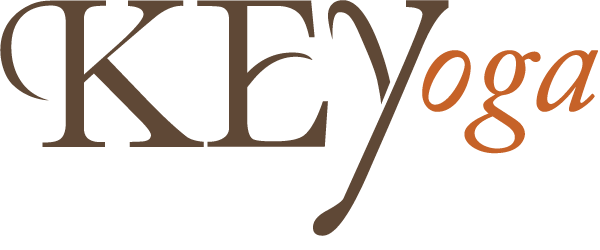Preparing for Astavakrasana with Side Angle Pose
Why you should never do Side Angle Pose with your elbow on your knee.
I am not a fan of doing Side Angle Pose with your elbow on your knee. I prefer putting your hand on the floor or on a block. There are always exceptions and I understand that for some people that may be the best variation.
See how the lower shoulder is collapsed as I rest my weight into that elbow instead of lifting up off it?
However, the primary reason I don’t recommend the bent elbow version of this pose is because when students put their elbow on their knee in Side Angle, there is a tendency to collapse into that bottom shoulder.
They can be made aware of that and they can learn to press their elbow into their knee and open the chest and collar bone on that lower side, but that action is often not taught. It is much more natural to press down into the bottom hand when it is on the floor or on a block. But still, that action of opening the bottom chest needs to be demonstrated and taught.
If you are doing a gentle yoga class and you are just moving through some basic poses, then there might not be a reason to go any deeper into Side Angle Pose than elbow to knee. But if you are doing a more progressive form of yoga where poses build on each other, then it is important to see and use Side Angle Pose as a gateway to more complex asanas.
Let’s take Astavakrasana, for example. In order to be able to approach this arm balance, you will need to develop the flexibility to get your shoulder under your bent knee. The entry into Astavakrasana comes from a pose called Eka Hasta Bhujasana which looks like this:
Eka Hasta Bhujasana, which means One Arm Leg Press Pose. You can see that I have to hook one of my legs over my shoulder.
This work begins in Side Angle pose where we work to get the bottom hand to the floor outside of the bent knee.
Notice the relationship of the knee and the shoulder. This is considered the full pose with the bottom hand on the floor.
When you take your hand to the floor, make sure that you do not allow your front thigh to drop below horizontal. Keep from doing this by pressing down on the outer edge of the back foot and lifting the inner back thigh away from the floor.
In the beginning, your hand may be on the tall side of a block, which is about the same height you would be in if you had your elbow on your knee.
Compare the height of the shoulder to the knee in this version of the pose with the picture of me with my elbow on my knee below. They appear to be practically at the same height. If the elbow rests on the knee, there is too big of a change to go from there to hand on the floor. But with your hand on the tall block, it is a gradual process of stretching to get the hand to the middle level of the block, to the lower level of the block and to finally getting the hand to the floor.
Performing this pose by placing the elbow on the knee prevents you from exploring your capacity to go deeper over time. This is a modification of Side Angle Pose. It is not the full pose.
But over time, you lower the block to its medium height and then to its lowest height until you can finally you put the hand on the floor.
The shoulder is getting lower as the flexibility in the hip increases.
If you look at the relationship of the shoulder and the knee full Side Angle Pose, you can see that they get very close together when you can get your hand to the floor.
The shoulder is getting even close to the knee.
No matter what stage you find yourself in Side Angle Pose remember to maintain the geometry of a straight line form back foot to top hand, front thigh parallel to the floor and front shin perpendicular to the floor.
If you are looking to improve your flexibility and range of motion then you can see why you would want to work towards the full version of Side Angle Pose. It is this flexibility that is necessary to do poses like Astavakrasana.
Astavakrasana, or Eight Crooked Places Pose.
Other postures that build on the flexibility of Side Angle Pose include: binding in Side Angle Pose, Bird of Paradise, Lizard Lunge, Revolved Side Angle Pose, Crow, Tortoise, Seated Wide Leg Forward Fold, Revolved Seated Tree and probably others that aren’t coming to mind right now.
































